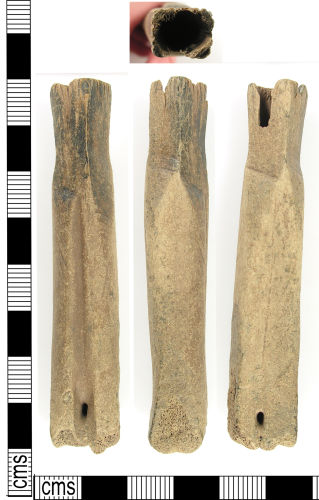I’ve been rather amused that my mudlarking to date has been
quite’ gendered’, no digging or getting dirty for me. Only finding and probably
looking for pottery, quintessential domestic remains. The boys on the foreshore
invariably have their detectors, I assume metal their primary interest, coins, tokens, buttons, keys, buckles, musket balls, canon balls and badges.
Scanning my selected patch I found my first metal find – pins – a wry
smile about their domestic origins. I’d seen the guys on Mudmen uncovering pins
on the foreshore, so I was half looking for these and there they were, not
exactly in their hundreds but quite numerous.
 |
| 17th ? Century Pins found Mudlarking on the Thames Foreshore |
 |
| 16th Century Pinner's Bone with grooves at top where pins were laid for sharpening, from Portable Antiquities Scheme |
Ordinary people would have a small number of pins, the
wealthy thousands. Janet Arnold documents the pin purchases from
Elizabetht I over 6 months
"Item
to Roberts Careles our Pynner for xviij [18] thousand great verthingale Pynnes
xx [20] thowsand great Velvet Pynnes and nyne thowsande smale hed Pynnes and
xix [19] thowsand Small hed Pynnes all of our great warderobe"
Pins were carefully looked after and sharpened periodically.
They were extracted after use so as not to tarnish the fabric and placed in a
pincushion. The portrait of Countess of Southampton shows her pincushion on the dressing table.
 |
Countess of
Southampton's Dressing Table with Pin Cushion 1590. From It's About Time
|

Great pins! I've never found any, but I will try and look out for some now. Fascinating stuff!
ReplyDeleteThese are brilliant,speaking as someone who grubs up bits and bobs all over the place but not the Thames. I am actually interested if you want to do a swap for some flint tools some time because I am doing a project for the Pendle witch trial and need to see the sort of pin they were accused of stealing for real.Let me know if you want to trade up. helen.hockin@o2.co.uk
ReplyDeleteI once found a gold pins with the sharp end spilt into two which may have been for keeping hair in place. Are there any experts out there who could enlighten me - I could send a photo? Thanks
ReplyDeleteSorry for taking time to reply, there is a good facebook page, London mudlark, where you can send photos of finds, she has a huge following who are very helpful in identifying finds. Good luck Julia
DeleteHi Julia,
ReplyDeleteHope you are well and still finding time to Mudlark. I am a researcher for a documentary series and have been looking for pictures of 17th century pins for a while with no luck. However I have found your picture and I was wondering if it would be possible to use your image in our programmme?
If you would be interested or want to chat about this more, please feel free to email me on:
camilla.borges@likeashot.tv
Many thanks,
Camilla x